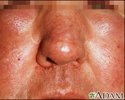Facial swelling
Puffy face; Swelling of the face; Moon face; Facial edema
Facial swelling is the buildup of fluid in the tissues of the face. Swelling may also affect the neck and upper arms.
Considerations
If the facial swelling is mild, it may be hard to detect. Let the health care provider know the following:
- Pain and where it hurts
- How long the swelling has lasted
- What makes it better or worse
- If you have other symptoms
Causes
Causes of facial swelling may include:
- Allergic reaction (allergic rhinitis, hay fever, or a bee sting)
- Angioedema
- Blood transfusion reaction
- Cellulitis
- Conjunctivitis (inflammation of the eye)
- Drug reactions, including those due to aspirin, penicillin, sulfa, glucocorticoids, and others
- Head, nose, or jaw surgery
- Injury or trauma to the face (such as a burn)
- Malnutrition (when severe)
- Obesity
- Salivary gland disorders
- Sinusitis
- Stye with swelling around the infected eye
- Tooth abscess
Home Care
Apply cold compresses to reduce swelling from an injury. Raise the head of the bed (or use extra pillows) to help reduce facial swelling.
When to Contact a Medical Professional
Contact your provider if you have:
- Sudden, painful, or severe facial swelling
- Facial swelling that lasts a while, particularly if it is getting worse over time
- Difficulty breathing
- Fever, tenderness, or redness, which suggests infection
What to Expect at Your Office Visit
Emergency treatment is needed if facial swelling is caused by burns or if you have breathing problems.
The provider will ask about your medical and personal history. This helps determine treatment or if any medical tests are needed. Questions may include:
- How long has the facial swelling lasted?
- When did it begin?
- What makes it worse?
- What makes it better?
- Have you come into contact with something you might be allergic to?
- What medicines are you taking?
- Did you recently injure your face?
- Did you have a medical test or surgery recently?
- What other symptoms do you have? For example: facial pain, sneezing, difficulty breathing, hives or rash, eye redness, fever.
References
Dinulos JGH. Urticaria, angioedema and pruritus. In: Dinulos JGH, ed. Habif's Clinical Dermatology: A Color Guide in Diagnosis and Therapy. 7th ed. Philadelphia, PA: Elsevier; 2021:chap 6.
Guluma K, Lee JE. Ophthalmology. In: Walls RM, ed. Rosen's Emergency Medicine: Concepts and Clinical Practice. 10th ed. Philadelphia, PA: Elsevier; 2023:chap 57.
Matlock AG, Pfaff JA. Otolaryngology. In: Walls RM, ed. Rosen's Emergency Medicine: Concepts and Clinical Practice. 10th ed. Philadelphia, PA: Elsevier; 2023:chap 58.
Pedigo RA. Oral medicine. In: Walls RM, ed. Rosen's Emergency Medicine: Concepts and Clinical Practice. 10th ed. Philadelphia, PA: Elsevier; 2023:chap 56.
Review Date: 2/2/2023
Reviewed By: Linda J. Vorvick, MD, Clinical Professor, Department of Family Medicine, UW Medicine, School of Medicine, University of Washington, Seattle, WA. Also reviewed by David C. Dugdale, MD, Medical Director, Brenda Conaway, Editorial Director, and the A.D.A.M. Editorial team.
















